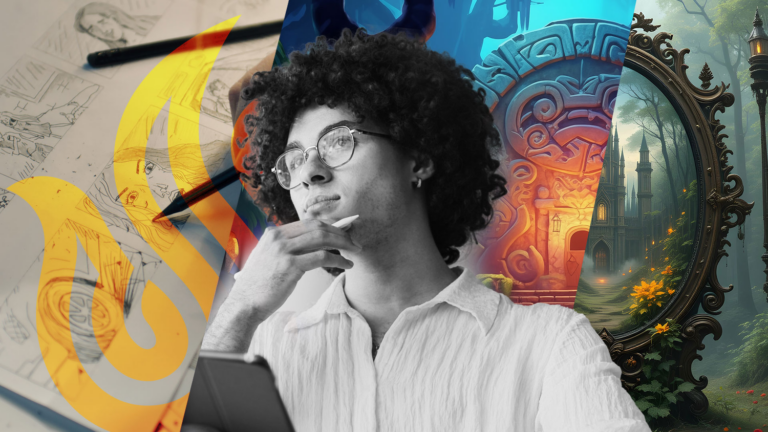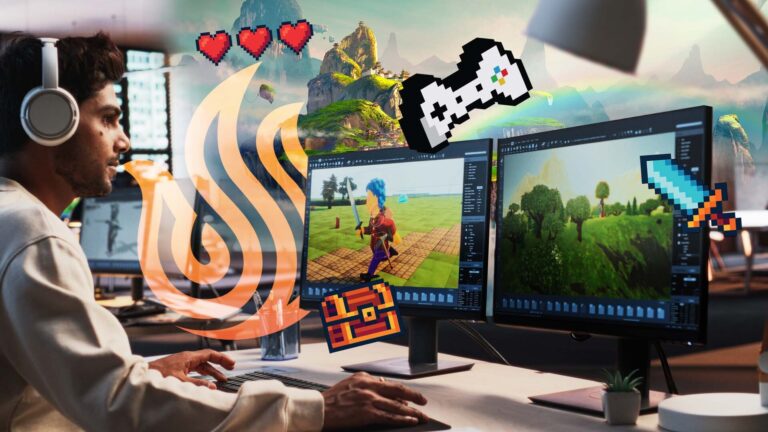The world of animation has enjoyed an unprecedented boon throughout the last few decades. Whether you prefer 2D or 3D animation, there is a cavalcade of wonderful to enjoy. If you appreciate both 2D and 3D styles, you have a practically endless supply of entertainment at your disposal. Considering the abundance of animated content created on a daily basis, there are just as many opportunities for creative artists to start working in animation.
Even if you are unsure whether you would prefer to work in 2D or 3D, it is important to start learning as much as possible about the digital entertainment industry. Equipping yourself with knowledge and some basic firsthand experience will help you decide. A suitable place to start is with the rest of this article. You will discover the differences between 2D and 3D animation, learn how to become an animator in the field of your choice, and explore the reasons why a formal education on the subject is your best resource for creating a successful career as a digital artist.
What is 2D Animation?
A 2D animation is a piece of content that remains within a flat plane during runtime. While many people think of 2D art as being exclusively hand-drawn, computer software is routinely used on modern 2D projects. As for the field of animation itself, it is the process of breathing life into a fictional setting by applying motion to the objects and characters in each scene. In real life, almost everything in your environment moves or reacts to forces acting upon it in some way. Stillness stands out as strange in our world of perpetual motion.
To make digital or hand-drawn art seem believable, motion is applied to the drawings or models created. The keyword here is believable, as animated properties are often far from realistic. In fact, the exaggerated nature of cartoons is a substantial portion of their appeal. Satisfying digital movements may be exaggerated, but it leads to the comedic or dramatic effects that both creators and audiences love.
Although 2D animation sticks to a flat surface, the use of perspective and other artistic techniques help simulate the depth that your eyes notice in the natural world. A pseudo-3D effect can be created using optical illusions and clever drawing tricks. A common example of this is drawing a cube on a piece of paper with carefully placed lines. Although you know it cannot possibly be a 3D image, a skilled artist can convey the multiple sides intrinsic to every cube you have ever seen.
What is 3D Animation?
3D animation involves the use of digital programs to recreate believable worlds using software. The same basic idea of breathing life into the world is relevant, but a whole new dimension of possibilities is used. Working in full 3D allows an artist to move away from the optical illusions that 2D creators rely on.
Most 3D projects are made with video game engines, regardless of whether or not the piece is interactive. This is because a game engine is set up with the functionality needed to create highly detailed 3D environments and facilitate all the interactions between them. 3D animators will also use special modeling software to create the various assets used in each digital scene.
3D animation can also refer to specialized forms, including stop-motion. Stop-motion takes numerous pictures of real-world objects and figurines to convey a sense of motion and tell a story. Claymation is the most common example of this, were all the 3D assets are molded from clay. The artist then incrementally modifies the position of each object and character between each photograph to articulate the narrative.
What is the Difference Between 2D and 3D Animation?
The most obvious difference between each animation style is the overall look. The flatness of 2D will always stand in stark contrast to full 3D forms. However, neither medium is necessarily better than the other. While 3D animation technically has more potential, it can create real life worlds and believable stories.
Artists who enjoy the technical challenge of getting the most from a software program will likely prefer 3D animation. 2D art has fewer limitations, but that leads to less intuitive guidance from the tools at your disposal. If you already have vivid images of what you wish to create in mind, then both 2D and 3D workspaces will be right up your alley.
How Do You Become a 3D Animator?
Since you want to start your career off on the right foot, you must give yourself the best chance for success. In the case of becoming a 3D animator, a creative arts college is the ideal avenue to choose. Obtaining a degree from a formal education program does more than check a box on a job application. A digital arts curriculum is where you will learn the ins and outs of the entertainment industry. Even when enrolled in an animation concentration, you will receive great insight into how other artists perform their tasks.
This well-rounded understanding of the digital entertainment process is crucial, even if you simply want to put your head down and animate. One of your main tasks will be to communicate with and remain on the same page as the rest of your creative team. A creative arts college gives you firsthand experience in doing just that. Many classes offer the opportunity to create your own animations through group projects. Not only will you practice your technical abilities, but you will practice soft skills that make you effective in any workspace.
What are the Benefits of a Formal Education in 3D Animation?
There are some advantages to attending, and graduating from, an accredited digital arts school. Here are just a few of the highlights that display the value of a curated education from reputable sources.
Industry Veteran Instructors
A solid roster of mentors will catapult you to new heights and prepare you for a professional work environment. Each instructor will have experience making published animated content. The best way to understand the animation process is to participate in it. Your instructors know how to make it in the world you are about to step into. This makes them a wealth of relevant knowledge and wisdom. Be sure to pay attention and learn as much as you can from each teacher throughout your degree program to get the most out of this benefit.
Experience With the Tools of the Trade
As mentioned above, the best way to learn animation is to create projects yourself. You need both the software and hardware used by professionals if you wish to produce top-of-the-line animation. The ideal setup may have a prohibitive cost for most hobbyists working from a home office. However, a digital arts school has what you need to create animation at a professional level. The curriculum gives you access to both hardware and software that is tough to come by. It also shows you exactly how to use each component to create a logical workflow.
If you are interested in innovative technologies, such as virtual reality, the facilities at your school will give you a chance to dabble in the nascent medium.
Networking Opportunities
One major aspect of getting hired is having contacts already working at the industry. Since your classmates will likely acquire positions at places you would also like to work at, getting to know your fellow students is a wise choice. You will practice teamwork and communication during your group projects so some friendships will form. Even when you are not naturally friends with a classmate, remaining in cordial contact is beneficial for both parties as your careers progress. After graduating, be sure to follow up with your network of classmates regularly to maintain the connection.
Career Services Representation
Digital arts colleges help graduates land their first industry job using their robust network of contacts at various studios and entertainment companies. These partners send entry-level job openings to the school, so graduates get the best chance of being interviewed and subsequently hired. You simply provide a profile of your interests and skills to the career services staff, and they match you with an opportunity based on your skillset. This leg-up on the competition is a major boon to any first-time job seeker.
What Else Do You Learn in a 3D Animation Concentration Program?
There are many additional topics that a formal education will cover during a Digital Art and Animation degree program with an emphasis in 3D animation. They include:
Foundational Art
Your animation curriculum contains the information necessary to facilitate each part of the animation pipeline. The education begins with a breakdown of traditional art techniques that have been passed through history. These tried-and-true concepts have stood the test of time thanks to their balance of technical prowess and creative ingenuity. By gaining foundational knowledge of art itself, you will be ready to tackle the digital tasks that lie before you.
Storyboarding
Once you get into the meat and potatoes of your training, you will start with pre-production principles such as storyboarding. A storyboard is a simple drawing of the animation’s narrative in a comic panel format. This provides a template for artists to abide by while working with digital assets.
Basic Principles of Animation
Next, you will study the basic principles of animation that are used to make fictional motions appealing to the audience. While the principles of animation remain incredibly similar in both 2D and 3D, the latter features some additional details to work out.
Character Rigging
For instance, 3D models require the use of character rigs to behave in a believable manner. Character rigging is the art of simulating the internal body structure of a being. Rigs can be applied to both humans and other creatures, but humanoid bodies require rigs to really sell the human motion to the audience. People are acutely aware of what it looks like when humans walk, jump, and perform other basic actions. 3D animators need to accurately convey human movement to avoid awkward interactions that pull the audience out of the story.
Video Editing and Film Production
You will continue to hone your animation skills as your group projects increase in scale. This leads to training in post-production concepts like video editing and film production. The ability to incorporate all your digital assets into a cohesive piece is the last step on your road to graduation. Not only will you see projects from start to finish, but there will be plenty of time to practice skills such as camera placement. Professional quality 3D assets must also be presented with merit for the full intended effect to materialize. By placing your work in the best possible light, you can surpass modern expectations and dazzle audiences with something truly special.
Video editing will complete the well-rounded skillset that prepares you for any job in the animation pipeline. Having some familiarity with all aspects of 3D design further increases the number of entry-level positions that are open to you.
Want to Learn More?
If your passion is for visual effects, 2D or 3D animation, or concept art for video games or blockbuster films, this is the Digital Arts & Animation degree program with 3D Animation for you. Gain the digital arts and animation skills you need to kick off your career in this dynamic and growing industry.
University of Silicon Valley is uniquely poised to offer a meaningful and valuable education for 21st century students. We believe in an education that directly correlates with the work you’ll be doing after you graduate. Interested in learning more? Contact Us today.


